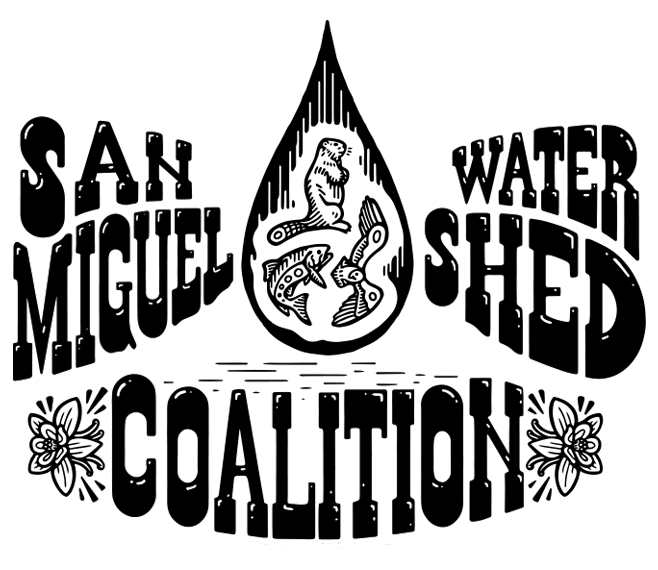Linda Luther Broderick
Coalition Co-Founder
Founding the Coalition
The San Miguel Watershed Coalition evolved from a Telluride Institute program beginning in the early 1990s. At that time, in the upper basin, Telco, now Telluride Ski and Golf Co, was implementing its snow making operation. The Skyfield Inc was planning for 2200 people on the West Meadows. Town of Mtn Village was becoming a reality. Town of Telluride was suing Idarado Mining Co. for water rights. The owners of the Telluride Valley Floor were in water court to perfect water rights for 150 acres of lakes to be constructed on the Telluride valley floor, including a 20 ft. high dam and another 15 ft dam. Town of Telluride was proposing a hydro project at the top of Keystone Hill that would divert the river into a penstock and return it at the bottom of Keystone Gorge.
In 1992, the Telluride Institute published a newspaper insert entitled The Citizens Guide to the Upper San Miguel River. It posed these questions: how much water is there, where is it, who owns the water, and what are their plans for it? in other words, who is designing the future?
In 1995, a group of about 70 people from up and down the river from Nucla to Mountain Village, braved a spring blizzard to meet and make the decision that it was worth it to try to work together to identify common issues and concerns…..with the only agenda being that if we all worked together on a few common topics our chances of success would increase.
Out of that first meeting, a watershed initiative was born, and the group itself, a large loosely organized group of citizens and local, state and federal officials, became known as the San Miguel Watershed Coalition.
The Coalition set about to identify and put in writing a common vision. Now the problem with identifying a common vision is that the San Miguel watershed compasses about a million acres of land. It includes parts of San Miguel and Montrose Counties, seven incorporated towns, numerous other settlements and every life zone represented on the Colorado Plateau. It also includes a number of different cultures, economies, lifestyles and certainly all of the issues of the New West vs the Old West.
The watershed has a wondrously rich mining legacy, and the all-to-often boom and bust cycles. The hard rock mining in the upper basin was coming to an end by the seventies. The uranium mining in the lower basin was bottoming out by the 1980s. More recently the upper basin had seen high resort and relocation rates with the associated impacts of resort growth, population flux, community separation issues and the loss of agricultural land.
It should be noted that during the Coalition’s formative years, two large scale Super Fund-sized mine cleanups were underway. The Umetco uranium cleanup at Uravan was wrapping up at the mouth of the river just as the Idarado hard rock mining cleanup was getting started in the headwaters. At Uravan, the cleanup allowed aquatic life to move upstream from the Dolores River and repopulate the lower river with warm water species. In the headwaters, Idarado’s water quality performance standard was sufficient to support a brown trout fishery. These two cleanups provided the foundation for much of the Coalition’s on the ground success and improved the baseline for watershed health.
In the meantime, this watershed is part of one of the largest remaining relatively undeveloped land masses in America and the San Miguel river which connects this landscape and the people who live on the land is one of only a few remaining relatively free-flowing rivers in Colorado.
So a great deal went into the Coalition’s first task, drafting the San Miguel Watershed Plan. All of the issues identified by the more than 150 persons who participated fell into 5 categories Water, Natural Resources, Recreation, Growth and Community Preservation, and Education and Stewardship. And the vision was to conserve and enhance the natural, cultural, recreational, social and economic vitality of the communities of this river basin.
A watershed initiative at its simplest is an effort in trying to unify people around the notion of thinking, acting and managing from the perspective of the watershed in which they live, rather than from the perspective of the piece of land on which they live or the political jurisdiction in which they live. It is about looking at the big picture, taking a systems view, looking at the health if the whole. It is about becoming an expert on where you live.
The work of the Watershed Coalition has been ongoing for some thirty years. Most of the action items in the Management Plan have long since been accomplished.
Today the challenges are much greater as impacts of climate change loom ominously.

